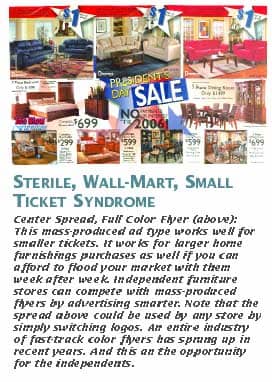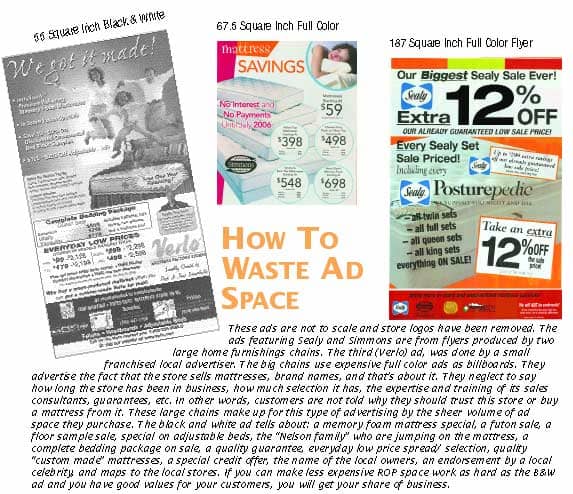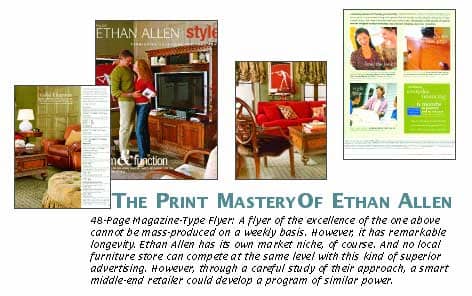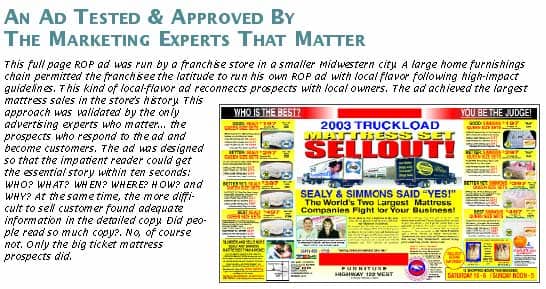Part 1: Huge retail chains and big box stores have monster budgets and corporate ad departments. Here’s how to out-advertise them.
Very few furniture entrepreneurs seem to know it yet, but the balance of advertising power is shifting in favor of the smaller furniture independent. While it is true that he or she faces massive advertising budgets from big box advertisers, there are also opportunities to carve out a greater market share. This two-part article, will present a “High Impact” strategy that independent retailers can use to boost advertising efficiency. This strategy demands that a great deal more attention be paid to advertising and promotional efforts.

This new strategy is based upon two “old-fashioned” principles, and one completely new one. First, the most important elements in effective advertising are sound merchandising and operations. Sound merchandising is wanted merchandise at fair prices that is supported operationally by passionate customer service (including paperwork, delivery, and so on. Second (and most important), there is only one marketing expert who counts. It is not Larry Mullins or your favorite bean-counter who does focus group research. The only marketing expert who counts is the customer who responds to your advertising and comes in to see if your story is true. In other words, if your advertising is not working, it is not correct. No amount of smoke and rhetoric about branding, or market research, or the promise of future sales will alter that basic fact. The third principle is an emerging factor, and one that makes the High-Impact strategy possible. This principle holds that big box advertisers are producing look-alike advertising that fails to tell their stories. Not only that, big central ad departments cannot make an emotional and personal local connection with the communities in which their stores are embedded. But the local, smaller furniture merchant can achieve this connection, and I will show you how. But first, let’s examine the reasons why big box advertising has become so expensive and wasteful.

The End of Advertising as We Once Knew It
When an executive watches a new TV commercial that is fresh from his agency or ad department, he enters a dream-world. He is thrilled by the glitz and color, insulated from the clutter, and forgets that a TV commercial can be the most wasteful form of advertising a retailer can use. True, if you are a big box you can flood the market with enough commercials to crowd out any other furniture advertiser.
V as a medium will continue to dominate general advertising for the foreseeable future. But this cannot hide the fact that TV (along with the internet) wastes huge amounts of retail advertising dollars. I am not the only one to observe this. Here is a comment from a recent Trends eMagazine:
“… the fact remains that neither TV nor the internet are very efficient at reaching the customers that vendors want to reach. At the main home page of Yahoo! for example, visitors are apt to see a big, expensive, animated ad for mortgages whether they are in the market for mortgages or not. Likewise, when viewers turn on the TV, they will probably see an ad for a new car, even when they just bought one yesterday. That’s a grossly inefficient use of marketing dollars. And that’s the norm. According to an article in INC magazine, 90 percent of automobile ads on the internet reach people who don’t want cars.”
TV in the future will become more interactive and nonlinear. But for the time being, it is a money pit for retailers of big ticket merchandise. The real issue is, how does the smaller furniture store compete with the sheer dominance of huge amounts of TV advertising from big box furniture operations? First, by not being afraid of it. TV is also an intrusive medium. Commercials for merchandise that customers have no immediate interest in are annoying. To compete, you will need to employ the synergy of several media alternatives that are far less intrusive and far more cost-effective. Not only that, but properly employed, these alternatives will produce traffic and volume such as you have rarely experienced. We will address these media and how they work in the February/March 2006 edition of FURNITURE WORLD Magazine.

Another issue that confronts smaller furniture stores is the mass of color furniture circulars that have become ubiquitous in newspapers. These flyers are less intrusive than TV, and much more cost-effective, however, they all increasingly look-alike. Moreover, they generally fail to tell a unique story, and project a cold, Wall-Mart corporate impression. There is no local color or content. These are mass-produced at lightening speed, and rely too heavily upon credit offers and gimmicks. The romance of beautiful furniture, comfort, and fashion is lost in a blur of hype, color, and undisciplined use of type and graphics. These circulars are, more often than not, produced by people who have not studied the bedrock essentials of effective print advertising. However, it cannot be denied that these flyers stir up furniture business. As long as no competitor is doing effective print advertising, they can dominate a market twelve months a year by sheer volume. The downside for them in all this is that most big box furniture stores are spending upwards of ten percent of their gross on advertising and promotion. This is far too much, and a needless extravagant waste that is due to weak, mass produced advertising by people who know how to crank it out, but not how to create effective messages.
There are notable exceptions to the lack of print expertise. Ethan Allen, for one, does a great job of producing flyers (generally mailed) and a large catalogue of their complete line-up. These productions give the homemaker a complete plan to create the environment of her dreams. They are produced by people who have studied the principles of good print advertising. True, they are difficult to produce. But they have remarkable longevity; women tend to save them.

Direct Mail Appeals
Big box furniture stores have also discovered the power of direct mail as a medium. Once again they dominate by flooding the market with volume and hype. These four aspects of advertising are rapidly changing: TV, the Internet, print and direct mail. The bean counters have been able to identify trends and buyer’s attitudes. This has enabled mass marketers to dominate markets with an unrelenting barrage of messages. This has worked for a time, but now the playing field has leveled again. The quality and effectiveness of the messages are becoming more and more important. In some areas, marketing by advertising dominance has made people more conscious of home furnishings. However, the information from focus groups and surveys is too often being interpreted by people who know the numbers but are unable to understand their meaning. Herein lies the opportunity for independent furniture dealers.
Data from the Bean Counters:
The late Peter Drucker predicted that the age of the bean counters is giving way to the newly emerging age of the creators and conceptualizers. The aforementioned Trends eMagazine agrees:
“The 21st century economy is rapidly unfolding as an age of right-brain thinking, dominated by creators, artists, inventors, designers, storytellers, caregivers, and visionaries. These are the people who search for meaning, identify opportunities, recognize patterns, create new ideas and empathize with other people.”
Of course, we still need data from the bean counters. But, don’t sit back and let them interpret it for you and attempt to translate it into advertising and promotional ideas! David Ogilvy was a great ad man who spent a small fortune on studies about how print advertising works. He tested and tested headlines, copy, and graphics and found the key to turning on consumers. He learned that a dark background behind type lowers readership up to sixty percent. Large blocks of copy in reverse are forbiddingly difficult to read. Large amounts of caps are killers to read. And on and on. Ogilvy actually led the revolution that used branding to supersede product. Most ad people in retail have never even heard of David Ogilvy, let alone read his books and timeless principles. But John Winsor, author of the recent and acclaimed Beyond the Brand, is smart enough to study many of the old researchers and students of effective print and integrate them with modern marketing concepts. He quoted Ogilvy on bean counters in his book:
“I notice increasing reluctance on the part of marketing executives to use judgment; they come to rely too much on research, and they use it as a drunkard uses a lamppost —for support, rather than for illumination.”
There are many horror stories that I could tell about misinterpreted data. One in particular comes to mind. A furniture industry research group recently held some costly focus groups and found that women prefer large pictures to small ones. They then deduced that women do not like to read advertising copy. The retail ad director jumped on this recommendation to use a few huge pictures and very little copy in his flyers. Why not? It’s the easiest way to put an advertising flyer together. The eventual result was the production of flyers with a few huge illustrations and very little copy. This formula proved predictably disastrous, long term, and very hard to reverse. Some knowledge of advertising principles and a bit of common sense tells us why.
A question to a general audience as to preference of large pictures over smaller ones is virtually rhetorical. Who would not agree? However, if you tested prospective furniture buyers with actual ads, you would surely get a different reaction. A good test would be one ad showing a huge illustration of a single sofa of a particular style, and another ad professionally designed with a larger illustration of a sofa and several smaller illustrations (indicating a wide selection of merchandise). Any furniture merchandiser using common sense would be able to discern the better presentation. Sterile item-price advertising is old fashioned and virtually useless on its own. Rifle-shooting with a single item at a hot price will result in a lady turning the page immediately unless the illustrated item happens to be the one she has her heart set upon. The cost of a page of rotogravure is unthinkably high to risk a full page with a single sofa sideways (as this company began to do). To make matters worse, there was no copy or other indication of a broad selection of other sofas at “equally exciting prices.” As to the assumptions made about not reading ad copy, it is true that very few people bother to read it. Only prospective customers read ad copy; especially large ticket customers who delay for a long time before seriously shopping for relatively expensive merchandise. This is not opinion. It is amply supported by authentic research and personal experience.
Think about it. You almost never notice an ad for tires until you need tires. If you do notice one, and you have no interest in tires, it is highly unlikely that you will read the ad. However, when the weather grows cold and you realize you need snow tires, you begin to notice all the tire ads. You begin to research snow tires. Then, you want to know something about the company that is advertising a sale on snow tires. You want to know something about the tires in the ad. Why are these tires so much more expensive than these? What makes them worth the extra money? Are they right for your car? Does your family’s safety make the more expensive tire a must buy? Are the people selling the tires trained experts? Do they back their products? Do they sell name brands?
Now think about the mattress presentations in a typical color flyer. They are typically very weak, uninformative and look-alike. Tempurpedic, although not consistent, has done some effective national advertising. These ads tell a story that is different and unique. No wonder Tempurpedic is a hot brand. Virtually no other mattress company is telling a compelling and interesting story. A good mattress salesperson can spellbind a customer with a presentation about the benefits of the correct sleep set. He or she can also give assurance of satisfaction, and present credentials giving evidence of expertise. But most furniture flyers are tongue-tied and use costly ad space like a billboard. Very easy for the ad department, but a huge waste of money for the store. Don’t kid yourself. A customer does not even see a mattress ad until she realizes hers is wearing out. Then she begins a process of considering where to buy a mattress, just as someone in the market for tires would do. Bigger ticket items have a large universe of medium-warm prospective customers at all times who are delaying and considering before actively shopping. It is this fact that makes the high-impact strategy a powerful and effective tool for wise retailers of big ticket items.
Take the time to read a recent Ethan Allen flyer. Compare it with the hastily prepared, mass produced flyers by the typical furniture chain. The lady who turns the pages of the Ethan Allen flyer learns something of the Ethan Allen story. She learns why Ethan Allen is unique, what they offer the customer in service and quality. Page after page of gorgeous displays are presented, with gracious copy embroidered with passionate and appealing words. She learns how easy it will be to get help from trained Ethan Allen consultants to design her rooms, and how to pay for everything. Ask yourself: Does it take a focus group to answer these questions: Do female prospects like to read about furniture fashion, elegant rooms, luscious new, durable fabrics? Do they care whether a store has faithfully served the community for over thirty years, or if it is a new, impersonal Big Box store with a fast track? And, does the prospect care at all if your store makes efforts to serve the community in which you are embedded?
Have You Looked at Your Website?
The internet is a small but growing medium. Internet ad spending has been growing at the rate of 20 percent in the last five years, now amounting to a $6.8 billion dollar market. Add-in paid searches on Google and Yahoo, and the total reaches $10 billion. This is formidable, but only 3 percent of the total advertising market. Most furniture retailers have established websites. Even so, they don’t pay a great deal of attention to them once they are up and running. Here is a challenge for you. Pretend you are a mattress customer and go to a good national website, such as Sealy, Simons or Stearns and Foster. Spend five minutes there. Then go to your own. Your website does not have to be fancy and glitzy, but it should be informative. Too many CEOs pay big bills for their website efforts but never bother to check them periodically. I can tell you that many of them need checking. Don’t leave it to the marketing department, it’s the last thing they bother with.
Is This A Hopeless Situation?
At this point you may protest: “Hey, wait a minute. This looks hopeless. You tell me that TV is expensive, intrusive, and cluttered. The Big Box boys dominate it. And you say they flood the market with flyers and direct mail. Yet you say I have an opportunity because they don’t apply the proven principles of advertising. And they don’t interface with the community. But I don’t know how to create ads either. My newspaper doesn’t know much about the dynamics that make ads work. And how am I going to interface with the community? What am I supposed to do?” These are fair questions. Please stay tuned.
Part II of this treatise is titled: A Proven High-Impact Strategy for Smaller Furniture Independents. In the February/March issue we will review and update the Seven Lost Secrets of Successful Furniture Promotions. This was the original series of articles published in Furniture World magazine over five years ago that has been updated for today’s selling environment. We will, for example, disclose to you how a modest-size store in Harlan, Iowa (a city with less than 6,000 people) recently applied these principles, and achieved $325,000 in profitable sales in three weeks with a high impact clearance sale. No, it was not by looking as though they were going out of business. No item-pricing was used. The store simply told its story and connected with the community with powerful conceptual ads. With very little guidance, the manager there, Linda Knoell, applied the principles of the Seven Lost Secrets to her clearance promotion. The owner of the store, Gary Hineline, wisely stepped back and allowed Linda’s local team to follow basic guidelines and do their thing. He was rewarded with a most remarkable retail sales performance.
I know you don’t want to sit on your hands until the next issue of Furniture World. So, why not look up David Ogilvy on the Amazon website? If you have time, try Claude Hopkins, and John Caples. And maybe read Beyond the Brand by John Winsor. These are the books the advertising experts at the big agencies read. And they are also the books read by the people who create successful advertising for retailers. Any person who must make advertising work in a cost-effective manner to stay in business continually studies the body of principles that have been researched, tested and proven. In this age of the big box furniture stores and mass-produced advertising mediocrity, the more the furniture entrepreneur learns about advertising the better his or her odds are for staying in business.
Contributing Editor Larry Mullins has 30+ years experience in the front lines of furniture marketing. Over the past ten years he has developed a remarkable new Visionary Management program that can impact the culture of an entire organization and bring it to life. He also produces state-of- the-art promotional advertising packages for everything from quick cash flow to complete exit strategies and store closings. Larry is President and CEO of UltraSales, Inc.. Inquiries on any aspect of promotional events or advertising can be sent to Larry care of FURNITURE WORLD at mullins@furninfo.com. See many more articles in the “Marketing Management” Index on furninfo.com .